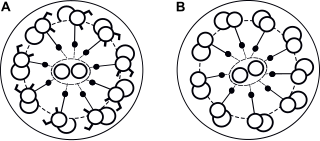
Primary ciliary dyskinesia (PCD) is a rare, autosomal recessive genetic ciliopathy, that causes defects in the action of cilia lining the upper and lower respiratory tract, sinuses, Eustachian tube, middle ear, Fallopian tube, and flagella of sperm cells. The alternative name of "immotile ciliary syndrome" is no longer favored as the cilia do have movement, but are merely inefficient or unsynchronized. When accompanied by situs inversus the condition is known as Kartagener syndrome.

An axoneme, also called an axial filament is the microtubule-based cytoskeletal structure that forms the core of a cilium or flagellum. Cilia and flagella are found on many cells, organisms, and microorganisms, to provide motility. The axoneme serves as the "skeleton" of these organelles, both giving support to the structure and, in some cases, the ability to bend. Though distinctions of function and length may be made between cilia and flagella, the internal structure of the axoneme is common to both.

Dynein light chain Tctex-type 1 is a protein that in humans is encoded by the DYNLT1 gene.

Cytoplasmic dynein 2 heavy chain 1 is a protein that in humans is encoded by the DYNC2H1 gene.

Dynein axonemal heavy chain 5 is a protein that in humans is encoded by the DNAH5 gene.

Dynein heavy chain 9, axonemal is a protein that in humans is encoded by the DNAH9 gene.

Dynein axonemal intermediate chain 1 is a protein that in humans is encoded by the DNAI1 gene.

Dynein heavy chain 11, axonemal is a protein that in humans is encoded by the DNAH11 gene.

Leucine-rich repeat-containing protein 50 is a protein that in humans is encoded by the LRRC50 gene.

Radial spoke head protein 9 homolog is a protein that in humans is encoded by the RSPH9 gene.

Radial spoke head protein 4 homolog A, also known as radial spoke head-like protein 3, is a protein that in humans is encoded by the RSPH4A gene.

Dynein axonemal intermediate chain 2 also known as axonemal dynein intermediate chain 2, is a protein that in humans is encoded by the DNAI2 gene.

Thioredoxin domain-containing protein 3 (TXNDC3), also known as spermatid-specific thioredoxin-2 (Sptrx-2), is a protein that in humans is encoded by the NME8 gene on chromosome 7.

Dynein axonemal light chain 1, (LC1) is a protein that in humans is encoded by the DNAL1 gene.

Kintoun, is a protein that is encoded by the DNAAF2 gene.

Radial spoke head 1 homolog (RSPH1), also known as cancer/testis antigen 79 (CT79) or testis-specific gene A2 protein (TSGA2), is a protein that in humans is encoded by the RSPH1 gene.

Sensenbrenner syndrome is a rare multisystem disease first described by Judith A. Sensenbrenner in 1975. It is inherited in an autosomal recessive fashion, and a number of genes appear to be responsible. Three genes responsible have been identified: intraflagellar transport (IFT)122 (WDR10), IFT43—a subunit of the IFT complex A machinery of primary cilia, and WDR35

Dynein, axonemal, heavy chain 7 is a protein in humans that is encoded by the DNAH7 gene.

Dynein, axonemal, heavy chain 14 is a protein that in humans is encoded by the DNAH14 gene.

CCDC40 is the gene in humans that encodes the protein named coiled-coil domain containing 40.

















